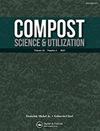Heat Recovery from Composting: A Comprehensive Review of System Design, Recovery Rate, and Utilization
IF 0.9
4区 农林科学
Q3 ECOLOGY
引用次数: 45
Abstract
ABSTRACT It has long been recognized that composting yields a large quantity of thermal energy, which is normally lost to the surrounding environment as heat. Efforts to recover this heat using compost heat recovery systems (CHRSs) have been sporadic. Literature on the subject is also disjointed. To summarize the research that has been conducted, the authors performed an extensive literature review, covering publications in scientific journals, trade magazines, books, theses, and published reports. A focus on CHRS design and heat recovery rates is presented. The review covers 45 CHRSs in 16 different countries, ranging from simple hotbeds used in China 2000 years ago, to advanced super-thermal conductor heat pipe systems in 2016. Heat recovery rates varied significantly, with no predictable trend among the 45 systems. Recovery rates averaged 1895 kJ/hr (1159 kJ/kg DM) for lab-scale systems, 20,035 kJ/hr (4302 kJ/kg DM) for pilot-scale systems, and 204,907 kJ/hr (7084 kJ/kg DM) for commercial systems.堆肥热回收:系统设计、回收率和利用的综合评价
人们早就认识到堆肥产生大量的热能,这些热能通常以热量的形式散失到周围环境中。利用堆肥热回收系统(CHRSs)回收这些热量的努力是零星的。关于这一主题的文献也是支离破碎的。为了总结已经进行的研究,作者进行了广泛的文献综述,涵盖了科学期刊、贸易杂志、书籍、论文和已发表的报告。重点介绍了CHRS的设计和热回收率。该审查涵盖了16个不同国家的45个chrs,从2000年前中国使用的简单温床到2016年先进的超热导体热管系统。在45个系统中,热回收率差异很大,没有可预测的趋势。实验室规模系统的平均回收率为1895 kJ/小时(1159 kJ/kg DM),中试规模系统的平均回收率为20,035 kJ/小时(4302 kJ/kg DM),商业系统的平均回收率为204,907 kJ/小时(7084 kJ/kg DM)。
本文章由计算机程序翻译,如有差异,请以英文原文为准。
求助全文
约1分钟内获得全文
求助全文
来源期刊

Compost Science & Utilization
农林科学-生态学
CiteScore
4.10
自引率
0.00%
发文量
0
审稿时长
>36 weeks
期刊介绍:
4 issues per year
Compost Science & Utilization is currently abstracted/indexed in: CABI Agriculture & Environment Abstracts, CSA Biotechnology and Environmental Engineering Abstracts, EBSCOhost Abstracts, Elsevier Compendex and GEOBASE Abstracts, PubMed, ProQuest Science Abstracts, and Thomson Reuters Biological Abstracts and Science Citation Index
 求助内容:
求助内容: 应助结果提醒方式:
应助结果提醒方式:


